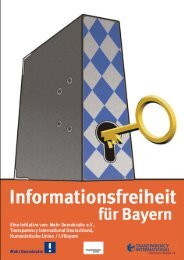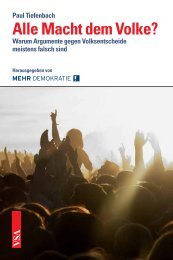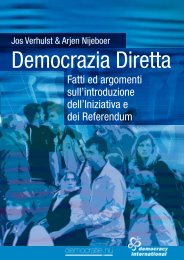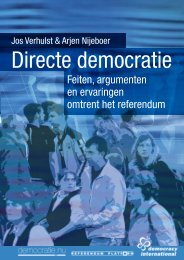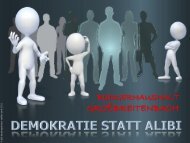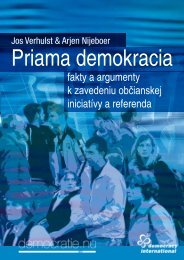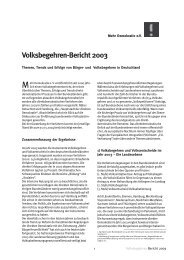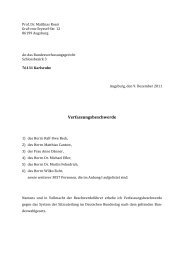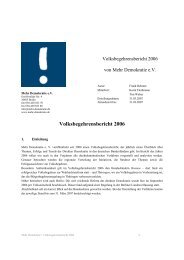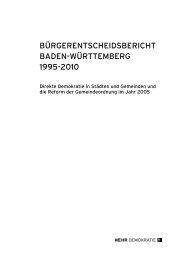Facts and Arguments about the Introduction of Initiative and ...
Facts and Arguments about the Introduction of Initiative and ...
Facts and Arguments about the Introduction of Initiative and ...
Create successful ePaper yourself
Turn your PDF publications into a flip-book with our unique Google optimized e-Paper software.
The municipalities levy <strong>the</strong>ir own taxes on income <strong>and</strong><br />
property. In Switzerl<strong>and</strong>, <strong>the</strong> municipalities spend a little<br />
less per resident than central government does. Beedham<br />
(1996) gives <strong>the</strong> example <strong>of</strong> <strong>the</strong> municipality <strong>of</strong> Kilchberg<br />
(7,000 residents) on <strong>the</strong> shores <strong>of</strong> Lake Zurich. The village<br />
arranges its own education, has its own fire brigade, an old<br />
people’s home, <strong>and</strong> its own policemen with two police boats<br />
on <strong>the</strong> lake. The municipality gives its few very poor people<br />
3,000 Swiss francs per person a month (more than £1,300<br />
a month), <strong>and</strong> also helps a h<strong>and</strong>ful <strong>of</strong> refugees, mainly from<br />
Sri Lanka. There is a municipal council <strong>of</strong> seven elected<br />
councillors, who monitor <strong>the</strong> work <strong>of</strong> <strong>the</strong> small number <strong>of</strong><br />
municipal <strong>of</strong>ficials. The real power <strong>of</strong> decision, however, lies<br />
with <strong>the</strong> public assembly that meets four times a year. The<br />
public assemblies are usually attended by some 400 municipal<br />
residents; sometimes several hundred more when <strong>the</strong>re is<br />
something special on <strong>the</strong> agenda. These meetings set <strong>the</strong> tax<br />
rates, approve new municipal byelaws, discuss <strong>the</strong> municipal<br />
accounts, consider construction plans, etc. These quarterly<br />
public assemblies constitute <strong>the</strong> highest level <strong>of</strong> municipal<br />
authority; <strong>the</strong> seven-person municipal council presents its<br />
recommendations to <strong>the</strong> meeting. Decisions are made by a<br />
show <strong>of</strong> h<strong>and</strong>s. A written secret ballot can be asked for by one<br />
third <strong>of</strong> <strong>the</strong> people present, but this option has never been<br />
used to date. The citizens who attend have great powers. Fifteen<br />
signatures are sufficient to obtain a municipal referendum<br />
via <strong>the</strong> public assembly, but this seldom occurs.<br />
Kilchberg’s public assembly once more illustrates <strong>the</strong> absurdity<br />
<strong>of</strong> participation quorums (chapter 2). A supporter <strong>of</strong><br />
<strong>the</strong> quorum system would probably say that a public assembly<br />
at which 400 <strong>of</strong> <strong>the</strong> 7,000 residents were present is ‘not<br />
representative’. In reality, <strong>the</strong> public assembly constitutes a<br />
super-representative municipal council. This large municipal<br />
council has a m<strong>and</strong>ate, just like a traditionally elected<br />
municipal council. Anyone who goes to <strong>the</strong> meeting is a<br />
m<strong>and</strong>atory; anyone who stays at home gives a m<strong>and</strong>ate to <strong>the</strong><br />
meeting. And Kilchberg is well managed. The allegation that<br />
direct popular management leads to failures is disproved<br />
<strong>the</strong>re in practice.<br />
Effects <strong>of</strong> Swiss direct democracy<br />
The many referendums that have been held over more than<br />
150 years in Switzerl<strong>and</strong> provide a goldmine <strong>of</strong> information<br />
on what happens if <strong>the</strong> people are able to take <strong>the</strong>ir destiny<br />
into <strong>the</strong>ir own h<strong>and</strong>s. A group <strong>of</strong> economists <strong>and</strong> political scientists<br />
from <strong>the</strong> universities <strong>of</strong> Zürich <strong>and</strong> St. Gallen – Bruno<br />
S. Frey, Reiner Eichenberger, Alois Stutzer, Lars P. Feld,<br />
Gebhard Kirchgässner, Marcel R. Savioz <strong>and</strong> o<strong>the</strong>rs – have<br />
for some time been systematically studying direct democracy’s<br />
effects on policy <strong>and</strong> society. To this end, <strong>the</strong>y make use<br />
<strong>of</strong> <strong>the</strong> fact that large differences exist in <strong>the</strong> degree <strong>of</strong> direct<br />
democracy that Swiss cantons have. Because <strong>the</strong> cantons<br />
also have major powers – Switzerl<strong>and</strong> is in fact a confederate<br />
cooperation between sovereign cantons – it is possible<br />
to measure <strong>the</strong> specific effects <strong>of</strong> direct democracy in many<br />
areas. This means, <strong>of</strong> course, that in <strong>the</strong>ir statistical calculations<br />
<strong>the</strong>y always discounted <strong>the</strong> o<strong>the</strong>r factors that could influence<br />
<strong>the</strong> studied relationship (<strong>the</strong> ceteris paribus principle<br />
[o<strong>the</strong>r things being equal]). In 1999, Kirchgässner, Feld <strong>and</strong><br />
Savioz summarised a large number <strong>of</strong> studies in <strong>the</strong> study<br />
Die Direkte Demokratie: Modern, erfolgreich, entwicklungs- und<br />
exportfähig (‘Direct Democracy: Modern, successful, exp<strong>and</strong>able<br />
<strong>and</strong> exportable’). But a lot <strong>of</strong> new studies have also been<br />
published since <strong>the</strong>n. Several <strong>of</strong> <strong>the</strong> most striking research<br />
results are shown below:<br />
1<br />
• Feld <strong>and</strong> Savioz (1997) took an accurate index <strong>of</strong> <strong>the</strong> degree<br />
<strong>of</strong> direct democracy in all <strong>the</strong> Swiss cantons <strong>and</strong> correlated<br />
this with <strong>the</strong> economic performance <strong>of</strong> <strong>the</strong> cantons<br />
at various times between 1982 <strong>and</strong> 1993. After having performed<br />
extensive processing <strong>and</strong> excluding alternative explanations,<br />
<strong>the</strong>y concluded that, depending on <strong>the</strong> point in<br />
time, <strong>the</strong> economic performance in <strong>the</strong> cantons with direct<br />
democracy was between 5.4 <strong>and</strong> 15 percent higher than in<br />
<strong>the</strong> representative cantons. “The coexistence <strong>of</strong> representative<br />
<strong>and</strong> direct democracies in Switzerl<strong>and</strong> raises a natural<br />
question: if direct democracy is more efficient than representative<br />
democracy, why do <strong>the</strong> representative democratic<br />
cantons not adopt <strong>the</strong> successful strategies <strong>of</strong> <strong>the</strong>ir neighbours?”<br />
asked Feld <strong>and</strong> Savioz (1997, p. 529).<br />
• Pommerehne surveyed <strong>the</strong> 103 largest towns <strong>and</strong> cities<br />
<strong>of</strong> Switzerl<strong>and</strong> on <strong>the</strong> link between direct democracy <strong>and</strong><br />
<strong>the</strong> efficiency <strong>of</strong> <strong>the</strong> government, with <strong>the</strong> treatment <strong>of</strong><br />
waste as <strong>the</strong> example. In <strong>the</strong> towns <strong>and</strong> cities with direct<br />
democracy, <strong>the</strong> treatment <strong>of</strong> waste was – o<strong>the</strong>r things being<br />
equal –10 percent cheaper than in <strong>the</strong> towns <strong>and</strong> cities<br />
without direct democracy. Moreover, Pommerehne found<br />
a considerable cost saving if <strong>the</strong> treatment <strong>of</strong> waste was<br />
contracted out to a private company. The towns <strong>and</strong> cities<br />
with direct democracy <strong>and</strong> private treatment <strong>of</strong> waste<br />
had costs that were 30 per cent lower – o<strong>the</strong>r things being<br />
equal – than in <strong>the</strong> cities with a representative system <strong>and</strong><br />
public treatment <strong>of</strong> waste. (Kirchgässner, Feld <strong>and</strong> Savioz,<br />
1999, p. 98-100)<br />
• Kirchgässner, Feld <strong>and</strong> Savioz (1999, p. 92-98) examined 131<br />
<strong>of</strong> <strong>the</strong> 137 largest Swiss municipalities to determine <strong>the</strong> link<br />
between direct democracy <strong>and</strong> public debt, using data from<br />
1990. In <strong>the</strong> municipalities where referendums on public<br />
expenditure were permitted (an example <strong>of</strong> direct democracy),<br />
o<strong>the</strong>r things being equal, <strong>the</strong> public debt was 15 percent<br />
lower than in municipalities where this was not <strong>the</strong> case.<br />
• Feld <strong>and</strong> Matsusaka (2003) studied <strong>the</strong> link between public<br />
spending <strong>and</strong> direct democracy. Some Swiss cantons have<br />
a finance referendum (Finanzreferendum), with which <strong>the</strong><br />
citizens must approve all local government decisions on<br />
expenditure above a certain amount (<strong>the</strong> average is 2.5 million<br />
Swiss francs). In cantons that have such a referendum,<br />
public spending between 1980 <strong>and</strong> 1998 was an average <strong>of</strong><br />
19 percent lower than in those without this instrument.<br />
• Benz <strong>and</strong> Stutzer (2004) studied <strong>the</strong> link between direct<br />
democracy <strong>and</strong> <strong>the</strong> level <strong>of</strong> citizens’ political knowledge,<br />
both in Switzerl<strong>and</strong> <strong>and</strong> in <strong>the</strong> EU. For Switzerl<strong>and</strong>, <strong>the</strong>y<br />
ga<strong>the</strong>red information from 7500 inhabitants <strong>and</strong> correlated<br />
this with <strong>the</strong> 1 to 6 index <strong>of</strong> <strong>the</strong> level <strong>of</strong> direct democracy<br />
for <strong>the</strong> 26 cantons. The highest level <strong>of</strong> direct democracy<br />
was found in <strong>the</strong> Basle canton, with an index <strong>of</strong><br />
5.69; <strong>the</strong> lowest level was in <strong>the</strong> Geneva canton, its index<br />
figure being 1.75. O<strong>the</strong>r relevant variables were checked,<br />
including gender, age, education, income <strong>and</strong> whe<strong>the</strong>r or<br />
not <strong>the</strong> people were members <strong>of</strong> a political party. They<br />
concluded that, o<strong>the</strong>r things being equal, <strong>the</strong> difference<br />
in political knowledge between an inhabitant <strong>of</strong> Geneva<br />
<strong>and</strong> Basle was considerable <strong>and</strong> amounted to <strong>the</strong> same as<br />
<strong>the</strong> difference between being a member <strong>of</strong> a political party<br />
or not, or between <strong>the</strong> monthly income groups <strong>of</strong> 5000<br />
<strong>and</strong> 9000 Swiss francs. For <strong>the</strong> EU, in which 15 European<br />
countries were studied, <strong>of</strong> which six had held a national<br />
referendum in <strong>the</strong> last four preceding years, <strong>the</strong>y discovered<br />
similar results.



